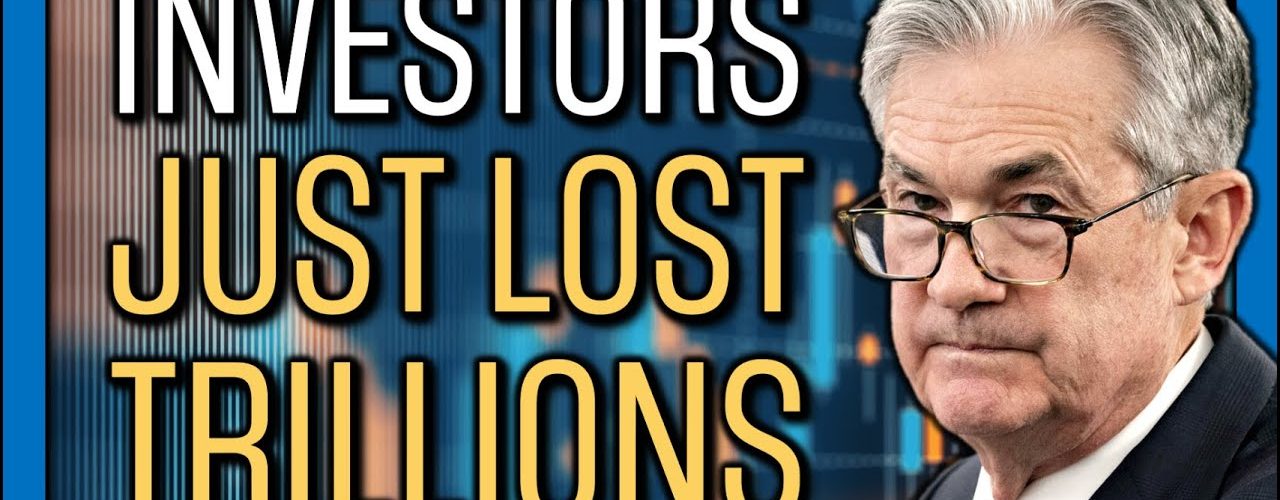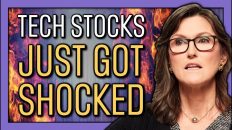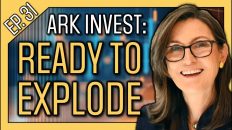Mentioned in Video:
- ⚠️ PREPARE NOW: A HUGE Stock Market Crash Is Coming: https://www.youtube.com/watch?v=YkqGDVxQE8s
- Fed Shifts to Inflation Battle, Winding Down Pandemic Support: https://www.nytimes.com/2021/12/15/business/economy/inflation-fed-fomc-meeting-december-2021.html
- Inflation Has Arrived. Here’s What You Need to Know. https://www.nytimes.com/article/inflation-definition.html
- Consumer Prices Rose at Fastest Pace Since 1982, Pressuring Washington. https://www.nytimes.com/2021/12/10/business/cpi-inflation-november-2021.html
- Support the channel and get extra member-only benefits by joining us on Patreon: https://www.patreon.com/tickersymbolyou
⚠️ The Federal Reserve and Jerome Powell are signaling that members are concerned about #inflation and are accelerating the taper of quantitative easing. This, along with news of the pandemic has led to a serious #correction in the tech stocks and growth stocks that Cathie Wood invests in like Tesla stock (TSLA) and Palantir (PLTR stock) over the last 4-6 weeks. Here's what I'm doing as the stock market crashes: increasing my cash position, my “cash-like” positions, investing in alternative assets like #cryptocurrency, and watching a few key indicators to stay informed.
Video Transcript:
00:03
If you're not familiar with Jerome Powell or quantitative easing,
00:26
let me give you a quick rundown of what's going on. Then I'll talk about what this means for us,
00:29
as growth oriented investors who follow ARK Invest and the Metaverse Index
00:33
and emerging markets, and so on. Then I'll tell you exactly what I'm watching out for and
00:37
what I'm buying moving forward. Your time is valuable, so here's a quick summary up front:
00:42
the Federal Reserve is stopping the money printer completely over the next 4 months
00:47
and is now expecting to raise interest rates several times over the next few years.
00:51
Research shows this could be even worse for growth stocks than we expect. Either way, in the short
00:57
to medium term, growth stocks in general and probably fintech stocks specifically are going
00:59
keep going down in price because they just got riskier. Since these growth stocks just got
01:03
riskier, I'm going to diversify my holdings a little more, both in terms of stocks and
01:09
in terms of other assets and I'll talk about exactly which ones. If you've got places to be,
01:11
that's the high-level overview. For those of you sticking around, let's get into the details.
01:15
As Jerome Powell said in that clip, the Federal Reserve has two goals: maximize employment
01:21
and keep prices stable. Right now, inflation is near a 30 year high. So, while lowering interest
01:27
rates and quantitative easing helped with maximum employment, it also caused prices to rise.
01:33
A lot. If you don't know what quantitative easing is, it's actually where the Federal
01:37
Reserve increases the money supply to encourage borrowing and investing by buying bonds on the
01:40
open market. So, when you hear big news channels talking about “tapering” or the winding down of
01:47
pandemic support, that's the Federal Reserve slowing down how many bonds they're buying until
01:52
they're no longer buying any bonds at all, which they expect to happen in March of next year.
01:58
Once that “money printing” hits zero, the Fed can begin raising the federal funds rate, which
02:03
is also called the overnight lending rate. The federal funds rate is the interest rate that banks
02:08
charge each other when they borrow money, which in turn determines the short-term interest rates
02:13
that banks and other lenders charge companies and individuals to borrow that money from
02:17
them. Currently, that lending rate is close to zero, which is great for growth stocks. Here's
02:18
the issue. Back in September, most Federal Reserve Officials agreed that this federal
02:23
funds rate will stay under 0.5% by the end of next year and around 1% by the end of 2023. As of this
02:31
last Fed meeting on December 15th, those estimates essentially doubled to roughly a 1% federal funds
02:38
rate by the end of 2022 and as high as 2% or more by the end of 2023. We should also consider the
02:46
possibility that the Fed could decide to raise this rate even higher if inflation data pushes
02:51
them in that direction. For example, Goldman Sachs Global Investment Research expects the
02:56
overnight lending rate to rise even faster through 2024 and reach over 2.5% in 2025. So, according to
03:04
them, the market needs to price in even MORE pain for growth stocks than it has been.
03:09
Let's stay on topic for now and I'll get back to this when I talk about the stocks I'm watching.
03:13
Rising interest rates are bad for growth companies because it now costs them more to borrow money
03:18
which they'll sometimes do to reinvest into their growth. It's even worse for younger Fintech
03:23
companies who are trying to acquire customers as cheaply as possible since now they have to charge
03:28
those customers more money for loans and lines of credit. That could slow their overall growth.
03:33
Yet another issue is when interests rates rise, bond prices usually fall, making them much more
03:38
attractive investments. When bonds get cheaper, risky growth stocks look riskier, since they have
03:44
to provide an even bigger return to outperform bonds. So, these rising interest rates can be
03:50
a real triple-whammy for growth stocks, which is why ARK Invest's funds are so sensitive to them
03:54
and why they've been underperforming the market all year. As a result,
03:58
I expect two things. First, I expect growth stocks to keep going down for a while.
04:03
I know. You're shocked. The other thing I expect is that they'll also get more volatile,
04:09
which will cause a lot of investors to panic sell stocks they don't have high-conviction in. Just
04:14
look at Tesla, which is ARK Invest's number one holding. Maybe it's yours too. Yes,
04:19
Tesla is down by over 20% over the last couple months, but look at how it got there. Volatility
04:25
is way up because the market literally cannot agree on Tesla's value. Is it a tech giant? Is
04:30
it growth company? At almost a trillion-dollar market cap, can it somehow be both?
04:35
If so, what exactly do these rising interest rates mean for Tesla as a result? The overall
04:40
market is confused on Tesla right now, so its share price looks like a literal rollercoaster.
05:31
Here's my honest advice. If rollercoasters aren't for you, don't get on the ride. There's
05:36
no shame in staying on the sidelines until YOU are ready. You also don't have to put ALL of
05:44
your money into these very volatile stocks if that's not for you. And if it IS for you,
05:48
you can still choose to average that money in over time instead of getting on the ride
05:53
all at once. Even though it's not always easy, averaging in is actually the simplest form of good
05:58
risk management. Diversifying your holdings is another form of good risk management.
06:03
Here's an example of a great little micro-portfolio of just four holdings:
06:07
Tesla, Palantir, the Grayscale Bitcoin Trust, and SPY, which tracks the S&P 500.
06:13
In just 3 positions, you've got exposure to the bleeding edge of artificial intelligence,
06:17
energy storage, robotics, enterprise software in a wide variety of markets, and a cryptocurrency
06:23
that more and more institutions are starting to put on their balance sheet. Then, you can use
06:27
the S&P500 as a hedge and lower the volatility of this little portfolio, all while still getting
06:33
some very reasonable returns. If you're keeping up with my portfolio project,
06:37
you're seeing me do this exact same thing, except I'm holding Ethereum and Bitcoin instead of GBTC
06:44
and I'm holding Google and Facebook instead of the entire S&P500. The less confident you are
06:49
in picking individual stocks like Tesla and Palantir, the more you can consider putting
06:54
into SPY until you clarify your position on your individual companies. It's not all-or-nothing.
06:58
What's that? You have a life with more important things to do than reading investor presentations
07:03
all day? Heh. Yeah. Me too. [shifty eyes]. That's where fund managers like Cathie Wood
07:08
and Matthew Ball come in. I'm not a financial advisor or professional money manager,
07:12
but they are. So I could take something like 5 or 10% of my money and put it in ARKK, which is
07:18
Cathie Wood's flagship innovation fund, or META, which tracks Matthew Ball's Metaverse Index.
07:23
By doing that, I've actually diversified the investing behavior that influences my returns
07:27
altogether, since a separate person would be managing some of my money. I would also gain
07:28
exposure to some new areas of technology, like genomics in ARKK and semiconductors in META, all
07:28
without compromising on my personal investment philosophy. I know what I hold and if I don't,
07:33
I at least understand why these fund managers hold things at a high level. Why is that important?
07:39
Because that's exactly how you get the conviction to hold these things as they drop 10, 20,
07:45
30%, or more in the first place, let alone buy more as they crash.
07:49
Here's the thing. When the Fed raises interest rates, all growth stocks are affected,
07:54
regardless of who is managing them. So, another way to protect yourself from volatility is to
07:59
invest in assets that aren't correlated to the stock market. I already mentioned one example,
08:05
which is cryptocurrencies like Ethereum and Bitcoin, or even the Grayscale Bitcoin Trust
08:10
which trades like a stock but tracks the price of Bitcoin. Another example would be real estate,
08:15
which is how YouTubers like Graham Stephan, Meet Kevin, and even Steven Mark Ryan got their
08:20
start. They can go for the more volatile kinds of growth stocks because they've spread their overall
08:25
financial risk across different asset classes like real estate and crypto. If I'm right
08:30
about growth stocks getting more volatile in the near future, I think assets that don't move the
08:34
same way as them should become more attractive as investments. Well, not everyone can afford
08:39
a mortgage and not everyone is comfortable with crypto or interested in pokemon cards,
08:45
so how can we invest in assets that aren't correlated to the stock market?
08:49
I actually spent a lot of time digging into this and the partner for today's video is a
08:53
great way to do just that. Masterworks dot IO is the only platform that lets you invest
08:58
in physical multi-million dollar paintings without breaking the bank.
09:07
Before I learned about Masterworks dot IO, I thought investing in art was only for the
09:11
super-wealthy, but I was wrong. I like Masterworks because, according to a recent report by Citibank,
09:17
fine art had the lowest correlation to the stock market of any major asset class, and
09:22
that's exactly what we're looking for as interest rates rise and growth stocks continue to fall.
09:27
Also according to Citi, contemporary art pieces have almost tripled the S&P500's total return
09:33
from 1995 to 2020. That's why billionaire art collectors allocate between 10 and
09:39
30% of their overall portfolios to art. That's way more than you thought, right?
09:45
The other thing I really like about Masterworks is that they're really focused on the investment,
09:49
not just the art. Their team of analysts use proprietary data to identify artists whose work
09:55
would produce the best risk-adjusted returns. Then, they acquire paintings by these artists,
10:00
file the artwork with the SEC, and then securitize it, meaning regular people like us
10:05
can buy shares of the artwork as if it were a stock. These aren't no-name artists drawing
10:11
animals on digital coins. In 2020, investors saw a 32% net return on their sale of Banksy’s
10:19
Mona Lisa. That’s two times better than the S & P 500. They also just got a brand new painting
10:25
by Pablo Picasso. Masterworks dot IO is disrupting one of the most exclusive asset classes in history
10:31
by giving everyone frictionless access to artists like Banksy and Picasso,
10:36
instead of just the ultra-wealthy. That's why I partnered with them. I think the reason
10:41
Masterworks has such a long waitlist is that they make something that used to be impossible
10:46
so easy. You go to Masterworks dot I O, create an account, browse their artwork, and can instantly
10:52
diversify your portfolio with one of the oldest and most stable assets around. So,
10:57
I reached out to them and they're giving you VIP access to their latest offerings, including that
11:02
new Picasso painting. I'll leave a link to that offer for you in the description below.
11:07
Great. We've covered the Fed working toward raising interest rates, the effects those interest
11:11
rates have on growth stocks, the potential increase in volatility of those growth stocks, and
11:16
ways to manage our risk accordingly, both inside our portfolio and out. Now let's bring it all
11:21
together and talk about specific stocks. This Goldman Sachs Forecast is really changing my 5
11:26
year outlook on growth stocks. If Goldman Sachs is right, the stock market is really only pricing
11:31
in about half the pain it should be from these future changes in interest rates. This is where
11:36
all the research that went into this episode comes together. There are two specific types of stocks
11:41
that I think are are becoming much more attractive right now, neither of which should be surprising.
11:46
The first kind are the mega-cap tech companies we all know and love today. Specifically, Google and
11:52
Microsoft. In addition to being big innovators in many different markets with fairly diversified
11:57
income streams, these companies all have high amounts of stable free cash flow and large cash
12:02
reserves on their balance sheets, so they don't really need to borrow as much money to grow.
12:07
Here's what makes these 2 companies special among the other tech giants like Facebook and Amazon,
12:12
as well as Nvidia and Tesla. They're much lower volatility. Microsoft has a beta of 0.87,
12:25
meaning it's even less volatile than the overall market. A beta of 1 would mean a stock is just
12:28
as volatile as the S&P500 over the last 3 years. Google has a beta of 1.07, so its price is also
12:32
very stable. This is a catch 22 because Google and Microsoft are big parts of the S&P500,
12:38
so they're defining the beta for the market. But if you're already investing in the market,
12:43
you might as well pick the technology innovators driving its baseline performance, not just its
12:51
measure of risk. Those are the reasons Google and Microsoft stand out from the rest, at least to me.
13:08
Google and Facebook are already in my portfolio and I'm thinking about adding Microsoft as well.
13:21
The other kinds of stocks I think are going to be great are the ones that are being mistaken
13:25
for Fintech stocks buuuuut they're not. For example, Sea Limited has 3 business units: Garena,
13:31
their online game development and publishing arm, Shopee, which is their big e-commerce marketplace,
13:36
and Sea Money, which is their digital wallet and payments solution. It's easy to look at Sea
13:41
Limited, say two out of three of their business units get hit by these interest rates, and write
13:45
them off as a Fintech company. Even though Shopee and Sea Money are quickly growing and exciting to
13:50
follow, all of actual their operating income comes from Garena, which is digital entertainment. This
13:56
is kind of like mistaking Tesla for an insurance company because Tesla insurance is a thing. I'm
13:57
not saying that this hundred billion dollar market cap company, which headquartered in Singapore and
14:01
makes most of its money through gaming, shouldn't be affected by these raising interest rates. I'm
14:06
just saying that maybe it shouldn't be as effected as Paypal and Square have been. I WOULD start a
14:16
position in Sea Limited, except it's already my number one position by a very large amount. So,
14:22
I'm watching out for more companies that the market appears to be mistaking for a small cap
14:27
fintech company when in reality they're something else. I'll keep you posted if I find more.
14:37
So, there you have it. Comment below or tweet me at Ticker Symbol
14:41
YOU with your thoughts on inflation, on volatility,
14:44
and on risk. Are you worried about the future of some of your favorite companies?
14:48
How far out are you thinking? Do you often think about your overall portfolio, including assets
14:53
outside of the stock market, or are you just looking for new stocks now that interest rates
14:58
are going to change? I read all my comments and tweets and I'm excited to hear your thoughts.
15:02
And if you want to be updated as soon as I make an investment decision instead of waiting
15:07
for me to make a video about it, consider joining my highest-tier Patrons on Patreon
15:11
or Channel Members right here on YouTube. Those supporters are getting a lot of extra
15:15
content each week as growth stocks keep trending downwards. If seeing me lose a ton of money
15:21
every day isn't really your thing, no worries, I totally get it. I talk about my portfolio
15:26
and its holdings here pretty often, whether they go up or down. [and it's gone]
15:31
Either way, I hope this episode helped you understand what's going
15:34
on with the Federal Reserve, what their updated policy means for growth stocks,
15:38
and gave you ideas for how to manage your risk inside your stock portfolio as well as outside of
15:45
it. Thanks for watching and until next time, this is Ticker Symbol YOU. My name
15:50
is Alex, reminding you, that the best investment you can make… is in you.
If you want to comment on this, please do so on the YouTube Video Here














